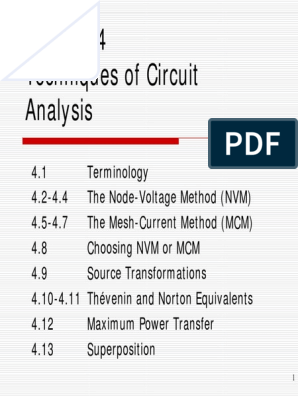0% found this document useful (0 votes)
400 views43 pagesBEE1133: Circuit Analysis I: Chapter 3: Method of Analysis (DC)
This document discusses circuit analysis using nodal analysis. It covers nodal analysis without voltage sources, including choosing a reference node, assigning voltages, applying Kirchhoff's Current Law (KCL) to get node equations, and solving the equations. It also discusses nodal analysis with voltage sources, including treating a voltage source between nodes as a supernode that requires applying both KCL and Kirchhoff's Voltage Law (KVL). Examples are provided to illustrate both cases. Exercises are included for students to practice applying nodal analysis.
Uploaded by
Natasha EmlynCopyright
© Attribution Non-Commercial (BY-NC)
We take content rights seriously. If you suspect this is your content, claim it here.
Available Formats
Download as PPT, PDF, TXT or read online on Scribd
0% found this document useful (0 votes)
400 views43 pagesBEE1133: Circuit Analysis I: Chapter 3: Method of Analysis (DC)
This document discusses circuit analysis using nodal analysis. It covers nodal analysis without voltage sources, including choosing a reference node, assigning voltages, applying Kirchhoff's Current Law (KCL) to get node equations, and solving the equations. It also discusses nodal analysis with voltage sources, including treating a voltage source between nodes as a supernode that requires applying both KCL and Kirchhoff's Voltage Law (KVL). Examples are provided to illustrate both cases. Exercises are included for students to practice applying nodal analysis.
Uploaded by
Natasha EmlynCopyright
© Attribution Non-Commercial (BY-NC)
We take content rights seriously. If you suspect this is your content, claim it here.
Available Formats
Download as PPT, PDF, TXT or read online on Scribd
/ 43






















































































